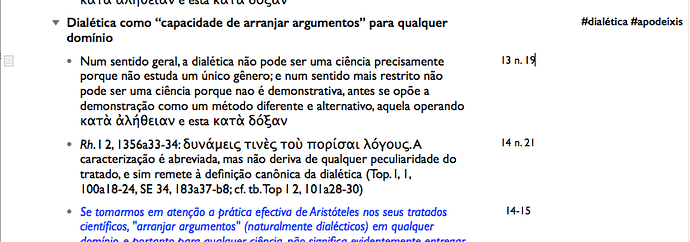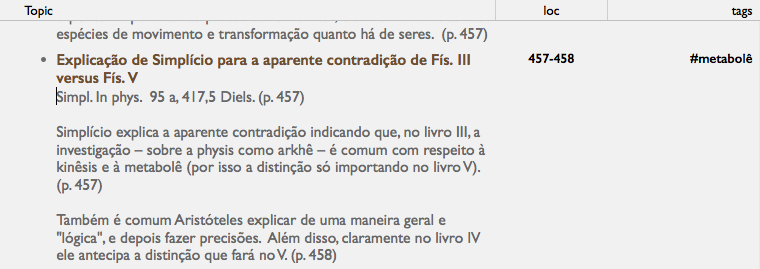The idea is to handle outlines I’m used to take with OmniOutliner, which are structures more or less like the above (the above in particular being somewhat complex and unusual anyway). Tinderbox of course enforces giving a $Name to a note, and assigning contents to a $Text attribute.
This has prevented me some years ago from adopting TBX, as I usually prefer building and rearranging the annotations as my reading progresses, eventually naming a topic and assigning it tags related to my research projects. Most of my existing outlines are like this:
I am now more tempted to adopt a two-stage approach with annotations, converting subrows to what in OmniOutliner jargon is called the “note” attribute of a cell, the equivalent of $Text in TBX (I’ve written a script for this purpose):
However, I can do the same thing inside TBX, collecting the $Names of sub-items and putting them in the $Text attribute of the relevant note (where $Name is actually a meaningful thing, naming the topic contained by its sub-notes). That would allow me to simply import my existing outlines as they are and deal with the relevant top-level notes with a stamp. The technical point being that TBX’s interface isn’t exactly smooth with long $Names for notes, as it was designed expecting extensive textual content to go in a $Text attribute.
But, to mention, the real interest in all this, and where TBX truly excels, is that I can collect appropriately tagged notes – including my own ideas, not only annotations from my bibliography – by means of Agents, using a $Tags.intersect($SearchTags(agent)) query. Those are “topic agents”, organized in an outline, corresponding to all different research subjects in a project, as they emerge. Having this analytical view of the research material is a real game changer, for as research progresses it becomes increasingly difficult to gather the material in a meaningful way (at a point in the final stage of writing my Ph.D. dissertation, I had to stop for a couple of weeks just to organize what I had, cutting pieces of outlines into text-formatted notes then-stored in DEVONthink – a solution that was roughly satisfactory).
I don’t know if my description was clear, but it tries to give a testimony on the way I’m working with TinderBox for this kind of notes 
As for the immediate problem with $OutlineDepth, though, I think I can live with a hard-coded calculation of where those topic notes from annotations normally reside in the document structure, and make ad hoc adjustments if needed.

